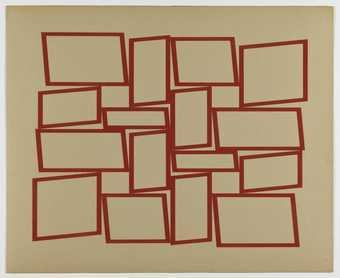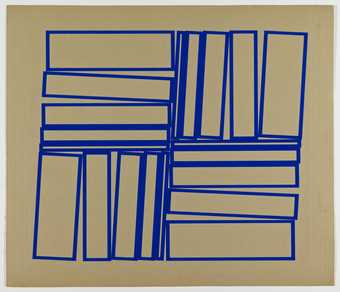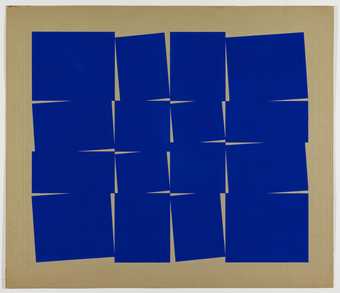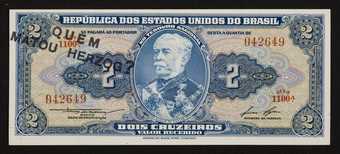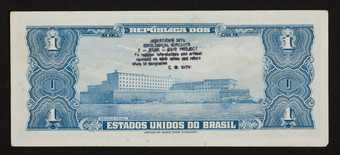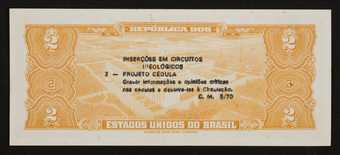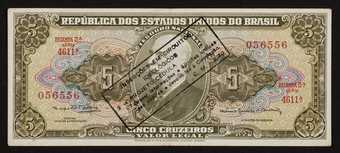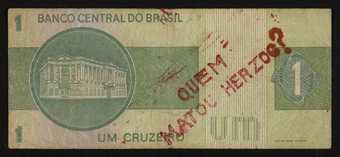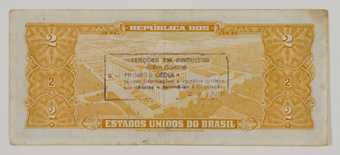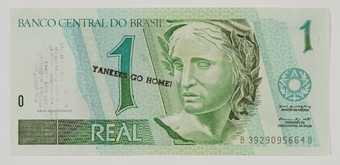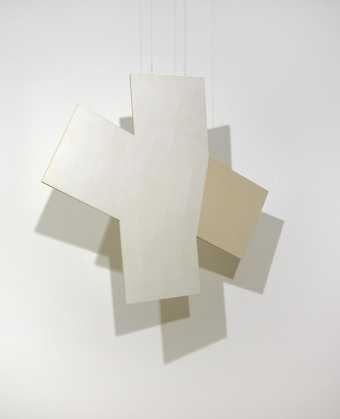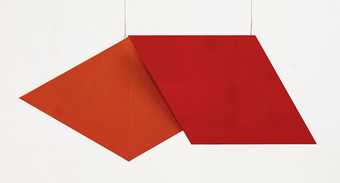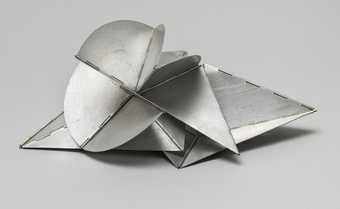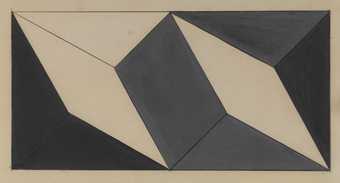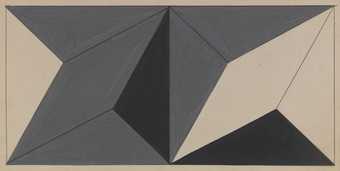
In Tate Liverpool
- Artist
- Lygia Pape 1927–2004
- Original title
- Tecelar
- Medium
- Woodcut on paper
- Dimensions
- Support: 450 × 330 mm
- Collection
- Tate
- Acquisition
- Purchased with funds provided by the Pinta Museum Acquisitions Program and Tate International Council 2011
- Reference
- P80082
Summary
Weaving 1957 is a woodcut in black ink printed on thin paper by the Brazilian artist Lygia Pape. The work is made up of a number of geometric forms, which overlap one another. The forms are comprised of horizontal grooves or lines that appear to be the result of the natural wood grain of the block used to make the print. Despite the simplicity of the shapes and patterns, the composition is complex giving the semblance of intersection, tessellation and superimposition, made more subtle by the effect of the wood grain which gives the work an optical impact similar to later op art.
This work comes from Pape’s series Weavings (Tecelares) made at the time of her involvement with the Grupo Frente in Rio de Janeiro, between 1955 and 1958. After 1961 she formed the neo-concretist group with the artists Helio Oiticica, Lygia Clark and others. Despite belonging to an earlier moment, Weaving employs many of the qualities that would later become associated with the neo-concretist response to European abstraction or concrete art. While concrete art described a form of abstraction dependent on geometry and divorced from the natural or organic, neo-concretism saw the re-emergence of these elements and a new interest in the presence of the spectator. By 1968 Pape had begun making large-scale participatory performances such as Divisor, but her interest in the viewer is also evident in the optical effects created in Weaving. In addition the graphic quality of the work is undercut by the uneven application of ink, making certain areas bolder and others less distinct. This small addition makes the process of producing the work visible and alludes to the artist’s hand, something which was usually minimised or absented in concrete art.
The Weavings encompass a wide range of abstract geometric compositions on various scales that employ the basic ink woodcut technique on thin, sometimes semi-transparent, paper. The woodcut technique was widely encouraged by the Brazilian state in the 1950s, favored for the democratic possibilities of reproduction. However, Pape created each Weaving in a single edition, treating them as individual works differentiated by the interaction of ink with the thin paper surface. To some extent the reference to weaving in the title relates to the conjunction of mechanised reproduction and skill or ingenuity, as well as evoking the tradition of textile work in the indigenous communities in Brazil. In this way Weaving juxtaposes modern ideas concerning reproduction, with traditional techniques making them the subject of individual, abstract works of art. The movement and malleability associated with textiles, as well as their proximity to the body also introduces another element of unruliness into the apparently fixed geometry of Pape’s work. The art critic Guy Brett has written about the artist with this in mind:
Her experiments paralleled those of Oiticica and Clark. All three invited this direct injection of subjectivity and bodily energy of the formerly passive spectator from a basis of geometric abstraction. This was indeed one of the implications which the Brazilians read in the work of Mondrian and Malevich.
(Guy Brett, ‘The Logic of the Web’, in Lygia Pape: Gavea de Tocaia 2000, p.307.)
Lygia Pape’s work was included in the Rio section of Century City at Tate Modern in London in 2001 and she featured prominently in the Venice Biennale in 2009 with the large scale installation Ttéia 1, C (Web) 2002/11. Pape was also the subject of a retrospective at the Museo Nacional Centro de Arte Reina Sofía in Madrid in 2011, which travelled to the Serpentine Gallery in London in 2012.
Further reading
Lygia Pape: Gavea de Tocaia, exhibition catalogue, Cosac and Naify, São Paulo 2000.
Lygia Pape: Magnetised Space, exhibition catalogue, Museo Nacional Centro de Arte Renia Sofía, Madrid 2011.
Kathy Noble, ‘Lygia Pape’, Frieze, no.145, March 2012, http://www.frieze.com/issue/review/lygia-pape, accessed 7 January 2016.
Tanya Barson
December 2010
Does this text contain inaccurate information or language that you feel we should improve or change? We would like to hear from you.
Display caption
Here Lygia Pape creates a complex composition out of simple rectangles and triangles. The title refers to the act of weaving, and thus to textiles, a reference that implies the transparency of woven fabric, as well as its regularity and precision. Each shape is made with a woodcut printed onto thin paper, with the grooves of the natural woodgrain of the printing block visible. This organic element, along with the overlapping of the shapes, deliberately disturbs the pure geometry of the work.
Gallery label, November 2015
Does this text contain inaccurate information or language that you feel we should improve or change? We would like to hear from you.
Explore
- abstraction(8,615)
-
- non-representational(6,161)
-
- geometric(3,072)
You might like
-
Hélio Oiticica Metaesquema
1958 -
Hélio Oiticica Metaesquema
1958 -
Hélio Oiticica Metaesquema
1958 -
Cildo Meireles Insertions into Ideological Circuits 2: Banknote Project
1970 -
Cildo Meireles Insertions into Ideological Circuits 2: Banknote Project
1970 -
Cildo Meireles Insertions into Ideological Circuits 2: Banknote Project
1970 -
Cildo Meireles Insertions into Ideological Circuits 2: Banknote Project
1970 -
Cildo Meireles Insertions into Ideological Circuits 2: Banknote Project
1970 -
Cildo Meireles Insertions into Ideological Circuits 2: Banknote Project
1970 -
Cildo Meireles Insertions into Ideological Circuits 2: Banknote Project
1970 -
Hélio Oiticica Bilateral ‘Teman’ BIL 003
1959 -
Hélio Oiticica Spatial Relief (red) REL 036
1959 -
Lygia Clark Creature-Maquette (320)
1964 -
Lygia Clark Planes on Modulated Surface (Study) (56)
1957 -
Lygia Clark Planes on Modulated Surface (Study) (61)
1957

